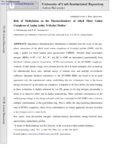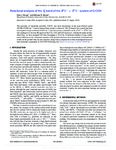|
|
Creator | Title | Description | Subject | Date |
| 226 |
 |
Morse, Michael David | Resonant two-photon ionization spectroscopy of NiC | A spectroscopic investigation of jet-cooled diatomic NiC has revealed a complex pattern of vibronic levels in the wave number range from 21 700 to 27 000 cm-1. Of the more than 50 vibronic bands observed, 31 have been rotationally resolved and analyzed. All are ?'=0+??"=0+ transitions, consistent wi... | | 2002 |
| 227 |
 |
Morse, Michael David | Resonant two-photon ionization spectroscopy of coinage metal trimers: Cu?Ag, Cu?Au, and CuAgAu | The jet-cooled coinage metal triatomic molecules Cu, Ag, Cu, Au, and CuAgAu have been investigated using resonant two-photon ionization spectroscopy. One band system, labeled as the ?-x system, has been observed for each species, with origin bands at 13 188, 17 217, and 17 470 cm -?, respectively. ... | | 1991 |
| 228 |
 |
Morse, Michael David | Resonant two-photon ionization spectroscopy of jet-cooled Au? | A band system of jet-cooled Au, has been located in the near infrared region of the spectrum using resonant two-photon ionization spectroscopy. The origin band is located at 13 354.15 cm-? and the system extends more than 700 cm-? further to the blue. The excited state displays a radiative lifetime... | | 1991 |
| 229 |
 |
Morse, Michael David | Resonant two-photon ionization spectroscopy of jet-cooled NiPt | Resonant two-photon ionization spectroscopy of jet-cooled NiPt has been used to investigate the possibility of <f-electron contributions to the bonding in this species. Based on an abrupt onset of predissociation, the bond strength of NiPt is assigned as D0 (NiPt) = 2.798 ? 0.003 eV. Comparisons of ... | | 1989 |
| 230 |
 |
Morse, Michael David | Resonant two-photon ionization spectroscopy of jet-cooled OsC | The optical spectrum of diatomic OsC has been investigated for the first time, with transitions recorded in the range from 17 390 to 22 990 cm?1. Six bands were rotationally resolved and analyzed to obtain ground and excited state rotational constants and bond lengths. Spectra for six OsC isotopomer... | | 2008 |
| 231 |
 |
Morse, Michael David | Resonant two-photon ionization spectroscopy of jet-cooled OsN: 520?418 nm | The optical transitions of supersonically cooled OsN have been investigated in the range from 19 200 to 23 900 cm?1 using resonant two-photon ionization spectroscopy. More than 20 vibronic bands were observed, 17 of which were rotationally resolved and analyzed. The ground state is confirmed to be 2... | | 2011 |
| 232 |
 |
Morse, Michael David | Resonant two-photon ionization spectroscopy of jet-cooled PdC | The first optical investigation of the spectra of diatomic PdC has revealed that the ground state has ?=0+, with a bond length of r0=1.712?. The Hund?s case (a) nature of this state could not be unambiguously determined from the experimental data, but dispersed fluorescence studies to be reported in... | | 1999 |
| 233 |
 |
Morse, Michael David | Resonant two-photon ionization spectroscopy of jet-cooled PdSi | The spectra of diatomic PdSi have been investigated for the first time, using the technique of resonant two-photon ionization spectroscopy. A number of vibronic transitions have been observed in the 20 400?22 000 cm?1 range. It is difficult to group the bands into band systems, although one likely... | | 2011 |
| 234 |
 |
Morse, Michael David | Resonant two-photon ionization spectroscopy of jet-cooled Pt? | The gas phase optical spectrum of jet-cooled Pt? has been investigated over the range of 11 300 to 26 300 cm -1 using resonant two-photon ionization spectroscopy in combination with time-of-flight mass spectrometry. Numerous vibronic bands are observed. Analysis of the data gives the location of som... | | 1988 |
| 235 |
 |
Morse, Michael David | Resonant two-photon ionization spectroscopy of jet-cooled PtSi | Jet-cooled diatomic PtSi, produced in a laser ablation supersonic expansion source, has been spectroscopically investigated between 17 400 and 24 000 cm-1 by resonant two-photon ionization spectroscopy. Two vibrational progressions are observed and identified as the [15.7]?'=1 ?X 1?+ and [18.5]?'=1 ... | | 1999 |
| 236 |
 |
Morse, Michael David | Resonant two-photon ionization spectroscopy of jet-cooled RuC | A resonant two-photon ionization study of the jet-cooled RuC molecule has identified the ground state as a 1?+ state arising from the 10?211?25rr42?4 configuration. The 3?i state arising from the 10?211?25rr42?312?1 configuration lies very low in energy, with the 3?3 and 3?2 components lying only 76... | | 1998 |
| 237 |
 |
Morse, Michael David | Resonant two-photon ionization spectroscopy of jet-cooled tantalum carbide, TaC | The optical spectrum of diatomic TaC has been investigated for the first time, with transitions recorded in the range from 17 850 to 20 000 cm?1. Six bands were rotationally resolved and analyzed to obtain ground and excited state parameters, including band origins, upper and lower state rotational... | | 2010 |
| 238 |
 |
Morse, Michael David | Resonant two-photon ionization spectroscopy of the 13-electron triatomic Si2N | Resonant two-photon ionization spectra of 28Si2N, 28,29Si2N, and 28,30Si2N have been collected between 32 000 cm-1 and 36 000 cm-1. A fit of the rotationally resolved spectrum of the most intense band of 28Si2N at 34 314 cm-1 reveals the transition to be 2?+u ? X~ 2IIg,1/2- A molecular orbital analy... | | 1996 |
| 239 |
 |
Armentrout, Peter B. | Role of methylation on the thermochemistry of alkali metal cation complexes of amino acids: N-methyl proline | Quantitative thermodynamic information is obtained from the study of the gasphase interactions of the alkali metal cation complexes of N-methyl proline (NMP) with Xe using a guided ion beam tandem mass spectrometer (GIBMS). Absolute bond dissociation energies (BDEs) of M+ = Li+, Na+, K+, and Rb+ to ... | | 2012-01-01 |
| 240 |
 |
Voth, Gregory Alan; Ayton, Gary S. | Role of protein interactions in defining HIV-1 viral capsid shape and stability: a coarse-grained analysis | Coarse-grained models of the HIV-1 CA dimer are constructed based on all-atom molecular dynamics simulations. Coarse-grained representations of the capsid shell, which is composed of approximately 1,500 copies of CA proteins, are constructed and their stability is examined. A key interaction between... | Virus capsid; HIV-1; Viral capsid shape; Coarse-graining; CA dimer | 2010-01 |
| 241 |
 |
Miller, Joel Steven | Room temperature molecular/organic-based magnet | The Du Pont / Ohio State University research team made materials in the laboratory, then tested them for magnetism. To do so, they initially moved a magnet along the outside of a sealed tube containing a small blob of experimental material and an inert gas such as argon or nitrogen. "We've done it... | Bis(benzene)vanadium; Vanadium; Tetracyanoethylene; TCNE; Polymeric magnets; Room temperature | 1991 |
| 242 |
 |
Morse, Michael David | Rotational analysis of the 30 1 band of the Ã6Σ+ ← X̃6Σ + system of CrCCH | The spectrum of chromium acetylide, CrCCH, has been investigated in the near-infrared region (10 500-14 500 cm−1) and an intense band system is observed. The 310 band of this system has been investigated at high resolution (0.025 cm−1) and this system is identified as the ˜A6 + ← ˜X6 + syste... | | 2014-01-01 |
| 243 |
 |
Morse, Michael David | Rotationally resolved spectra of Pt? | High-resolution laser-induced fluorescence spectroscopy has been used to investigate the 18 163 cm21 band of Pt2 in a supersonically cooled molecular beam. Rotational constants of the ground and excited states were extracted from the rotationally resolved spectrum and determined to be B0'=0.031 754(... | | 2002 |
| 244 |
 |
Morse, Michael David | Rotationally resolved spectra of jet-cooled RuSi | We report the first gas-phase spectroscopic investigation of diatomic ruthenium silicide (RuSi). The molecules were produced by laser ablation of a Ru disk into a flow of helium carrier gas containing 0.5% SiH4, and were cooled in a supersonic expansion. The RuSi molecules were then studied using re... | | 2007 |
| 245 |
 |
Morse, Michael David | Rotationally resolved spectra of jet-cooled VMo | The Author's report the first gas-phase spectroscopic investigation of diatomic vanadium molybdenum (VMo). The molecules were produced by laser ablation of a VMo alloy disk and cooled in a helium supersonic expansion. The jet-cooled VMo molecules were studied using resonant two-photon ionization sp... | | 2007 |
| 246 |
 |
Morse, Michael David | Rotationally resolved spectroscopy of jet-cooled NbMo | Rotationally resolved resonant two-photon ionization spectra of jet-cooled NbMo are reported for the first time. A vibronic spectrum of NbMo was recorded in the 17 300?22 300 cm?1 spectral region. Although the observed bands could not be grouped into electronic band systems, four excited vibronic le... | | 2007 |
| 247 |
 |
Morse, Michael David | Rydberg and pulsed field ionization-zero electron kinetic energy spectra of YO | A spectroscopic study of the Rydberg states of YO accessed from particular rotational levels of the A 2II1/2, v=0 state has been combined with a pulsed field ionization, zero electron kinetic energy (PFI-ZEKE) investigation. The results provide accurate values of the ionization energy of YO, ioniz... | | 1999 |
| 248 |
 |
Armentrout, Peter B.; Morse, Michael David | Rydberg and pulsed field ionization-zero electron kinetic energy spectra of YO | A spectroscopic study of the Rydberg states of YO accessed from particular rotational levels of the A²Π½, v=0 state has been combined with a pulsed field ionization, zero electron kinetic energy (PFI-ZEKE) investigation. The results provide accurate values of the ionization energy of YO, ionizati... | Ionization energy; Rydberg spectra; Yttrium monoxide | 1999 |
| 249 |
 |
Olson, Randall J.; Coldwell, Karin D.; Compton, Bruce J.; Giddings, John C. | Sedimentation field-flow fractionation: a method for studying particulates in cataractous lens | It is shown that the technique of sedimentation field-flow fractionation (sedimentation [sed] FFF) can be used to determine the particle content and particle size distribution of normal and cataractous lenses. A 31-year-old normal human lens, for example, showed a particle content of 1.5% by weight ... | Fractionation; Cataractous Lens; Particulates | 1984 |
| 250 |
 |
Stang, Peter J. | Self-assembly of coordinative supramolecular polygons with open binding sites | The design and synthesis of coordinative supramolecular polygons with open binding sites is described. Coordination-driven self-assembly of 2,6-bis(pyridin-4-ylethynyl)pyridine with 60? and 120? organoplatinum acceptors results in quantitative formation of a supramolecular rhomboid and hexagon, resp... | | 2010 |

























